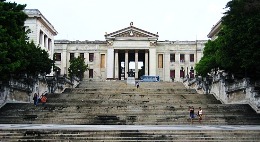Primary Education
Cuban education was nationalized in 1959 at a time when less than half the children had access to education. Today the island has the highest literacy rate in the world, although schooling does come at a cost of loyalty to the state, and an obligation to do community service as well. The process begins with 6 years of primary education, during which time the "3 R's" of
reading, riting and rhymetic are taught.
Middle Education
The purpose of the 3 years of middle education in Cuba is to provide a grounding in traditional school subjects like languages, technology and social science. Thereafter pupils choose to go on to secondary school, or switch to vocational training to prepare them for a practical career.
Secondary Education
The final 3 years of schooling at secondary level are an extension of middle school. This time though academic standards are tighter, and enthusiastic participation in school para-military parades a must. School holidays are spent doing one or other form of social service - the Cuban ethos is built on giving back. Those who complete are awarded a
bachillerato certificate.
Vocational Education
A student who proceeds to vocational training following middle school may follow two streams. These are skilled worker courses, and programs that provide middle-level technicians. Graduates of the latter courses with good grades have the choice of going on to technological institutes for further training.
Tertiary Education

Tertiary academic excellence is not new to Cuba, with the University of Havana being established in 1727. Today universities, higher institutes, higher pedagogical institutes, centers of higher education and polytechnic instiutes continue the tradition.
The ministry of higher education manages policy for both undergraduate and graduate programs. This includes course content, methodology, teaching and allocations of student places as well. Currently over 110,000 citizens are enrolled. Each and every one of these will deliver their new-learned skills for an equivalent number of years in rural communities, for far lower incomes than national rates.

 Tertiary academic excellence is not new to Cuba, with the University of Havana being established in 1727. Today universities, higher institutes, higher pedagogical institutes, centers of higher education and polytechnic instiutes continue the tradition.
Tertiary academic excellence is not new to Cuba, with the University of Havana being established in 1727. Today universities, higher institutes, higher pedagogical institutes, centers of higher education and polytechnic instiutes continue the tradition.